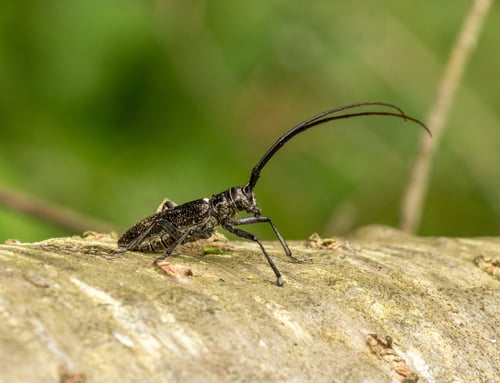Have you ever wondered about the weird looking bug you found? Insects, spiders, and other “not-so-creepy crawlers” are some of the coolest living things to find while exploring outdoors, whether we are in the backcountry, a local park or our own backyard! While many people may be fearful of bugs, they are amazing creatures with special survival adaptations. Learning to identify bugs is a great way to engage with our curious nature and learn which bugs are safe to be around. Rocks and logs are the best places to observe bugs. Here are three species we may encounter!

Wolf Spider
Wolf spiders are one of the bigger spiders found in Colorado at 4.3-6.3 mm. They do not spin webs, but hunt by chasing down other insects. They are non-venomous and typically run from humans instead of biting us. Wolf spiders can be identified by their size, color, and lengthwise stripes on their bodies. There are 2,300 species of wolf spiders worldwide!

Roly Poly
Whether you call it a roly poly, pill bug, wood shrimp, or chiggy pig, this is one of the most common critters we all know! They are actually not bugs, but crustaceans, like crabs, and breathe using gills. Rolling their bodies into a ball helps keep their gills moist and protect them from predators. You can identify these critters by the seven hard plates on their backs, slate gray color, and seven pairs of legs.

White-Spotted Sawyer
The white-spotted sawyer is a super neat species of longhorned beetle. Its antennae can be 1-3 times as long as its body! They live at high elevations on spruce and fir trees. This beetle can easily be confused with the spotted pine sawyer. The white-spotted sawyer can be identified by its long antennae, its size ranging between 16-23 mm, and the white spots on its body and antennae!
Keep an eye out for these amazing critters, as well as the many other species of spiders, crustaceans, beetles, ants, slugs and snails that reside under logs.
Many resources exist to learn more about these fun critters. If you are a book person, The National Geographic Pocket Guide Insects of North America uses accessible language and only lists 182 species. More advanced identifiers may prefer the National Wildlife Federation Field Guide To Insects and Spiders of North America or the Kaufman Field Guide To Insects of North America.
Another fantastic option is to explore with the free apps Seek and iNaturalist. If you get close enough to a bug, Seek can recommend a species level identification. You can post your observed insect and its location to the iNaturalist app. Community members and scientists will help you confirm the species as well as use the data that you have produced! You can also browse iNaturalist to see what species other folks have been observing.
An additional amazing website is whatsthatbug.com! You can browse the website's archive for information about different critters and make your own posts. By uploading photos, you can ask bug experts to help you identify insects.
Finally, social media can be an amazing identification resource and connect you with other insect curious folks! Two great Facebook groups you can join are this Entomology group and this Insect Identification Group to find people who can help you with learning and identification. Twitter also has @BugQuestions (Ask an Entomologist) and @RecluseOrNot.
This guide is just a start and you may find other resources that work better for you. I hope that this inspired or rekindled curiosity and appreciation about the awesome, not-so-creepy crawlers that live among us! Get out there and start identifying!
This article was written by Jaymee Squires, the current Director of Graduate Programs and the Senior Faculty Adviser at Walking Mountains Science Center in Avon, CO.







